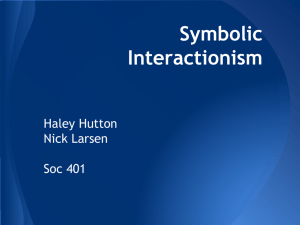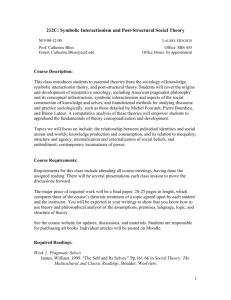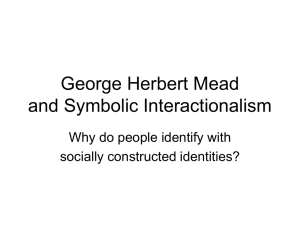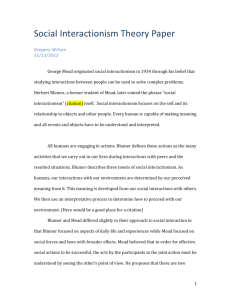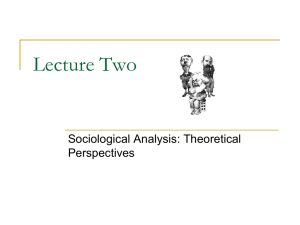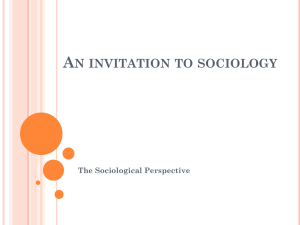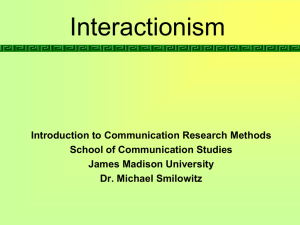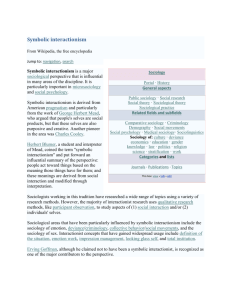Symbolic Interactionism
advertisement
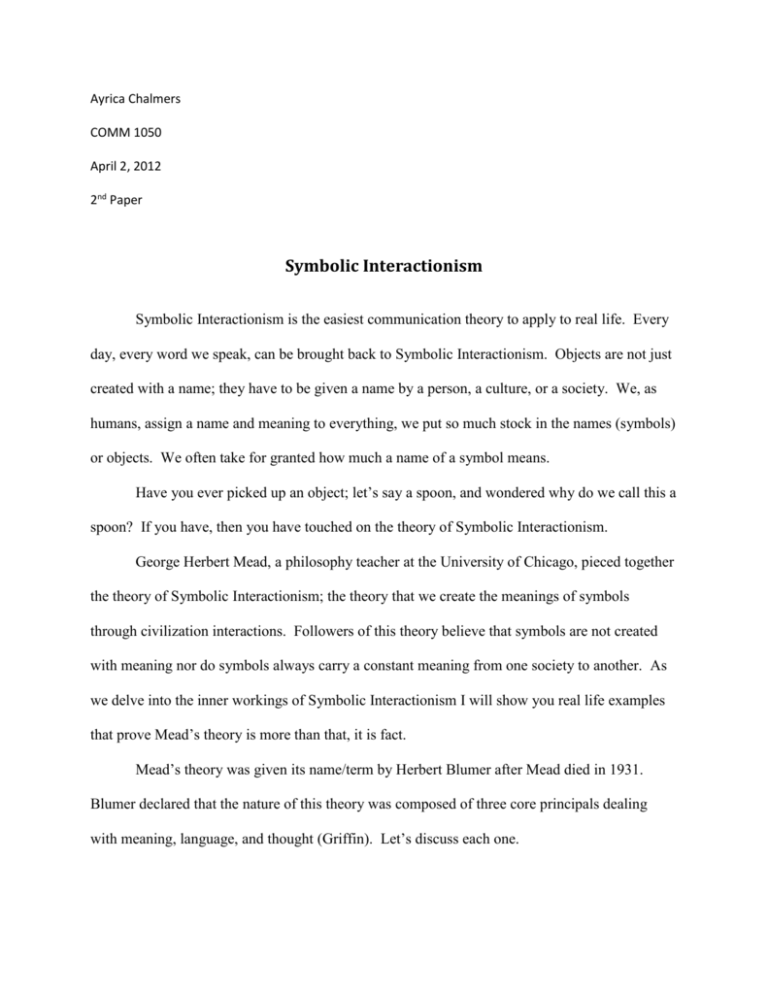
Ayrica Chalmers COMM 1050 April 2, 2012 2nd Paper Symbolic Interactionism Symbolic Interactionism is the easiest communication theory to apply to real life. Every day, every word we speak, can be brought back to Symbolic Interactionism. Objects are not just created with a name; they have to be given a name by a person, a culture, or a society. We, as humans, assign a name and meaning to everything, we put so much stock in the names (symbols) or objects. We often take for granted how much a name of a symbol means. Have you ever picked up an object; let’s say a spoon, and wondered why do we call this a spoon? If you have, then you have touched on the theory of Symbolic Interactionism. George Herbert Mead, a philosophy teacher at the University of Chicago, pieced together the theory of Symbolic Interactionism; the theory that we create the meanings of symbols through civilization interactions. Followers of this theory believe that symbols are not created with meaning nor do symbols always carry a constant meaning from one society to another. As we delve into the inner workings of Symbolic Interactionism I will show you real life examples that prove Mead’s theory is more than that, it is fact. Mead’s theory was given its name/term by Herbert Blumer after Mead died in 1931. Blumer declared that the nature of this theory was composed of three core principals dealing with meaning, language, and thought (Griffin). Let’s discuss each one. The first principal is meaning, the construction of social reality. The thought that humans act towards things and other people on the basis of the meanings they assign to those people or things (Blumer). Let’s say you witnessed a man stealing a purse from a woman, when three police officers show up at the scene they ask you to describe the man. You dig into your memory to recall the description and here is what you come up with; the man was tall, he had long blonde hair, he was wearing jeans, and a sweatshirt. Do you think that all three officers and yourself have the exact, or even similar man in mind? Does long hair mean chin length, shoulder length, or anything more than bald? When you say tall, is tall the same to you (a five foot woman) as it is to the three officers (varying heights from five foot seven to six foot three)? It is possible that the symbol, or word, tall could mean one thing to an Eskimo and another to an Amazon. It is also possible that long hair could be defined one way by a Marine and another by a Rock and Roll singer. The second principal is language, the source of meaning; Blumer’s premise that meaning arises out of the social interaction that people have with each other (Griffin). When we are born we do not possess the meaning of language and symbols. A baby looks at a dog and does not think “dog”. A baby looks a dog and thinks the description of the dog, what it looks like, feels like, and smells like. It is not until the baby’s parents distinguish the “thing” as a dog that he begins to associate the two symbols with each other. Now, you bring that same baby to France and the animal is no longer a dog, it is now a chien, French for dog (wordreference.com). Thought is the third principal set forth by Blumer. An individual’s interpretation of symbols is modified by his or her own thought process. Mead defined this inner dialogue as minding (Griffin). Minding, or self talk, is a form of rehearsing our actions or reactions before responding. Thought is how we navigate through every activity and piece of communication that we come across every day. We take in what we are seeing and/or hearing, we then translate it into the corresponding symbol that society has attached to it, and we are able to react based on that translation. It is thought that allows us to take on the role of others. When your boss reprimands you for being late, you are able to see the situation from his point of view, accept it and move on. You can relate to why he is upset that you are late. The movie Nell gives a perfect example of Symbolic Interactionism and its three corresponding principals. The movie is about a doctor, Jerome Lovell, who finds a woman, about thirty years in age named Nell, in an isolated cabin. The woman was raised by her mother whose speech was handicapped by a stroke. Besides her late mother and late twin sister, Nell has not had any interaction with another human being. Nell’s mother read to her from the bible in her slurred speech. It is from these readings that Nell learned her symbols, her meanings, language, and thought. In the movie, Nell draws different reactions from the characters she meets along the way. The town’s sheriff sees a demented woman who should be locked away in a nut house. The sheriff’s wife sees a free spirit. A psychiatrist sees a science project to test and research theories with. Her rescuer sees Nell as a regular human being who has a developed language of her own, based on what she learned and heard from her mother. According to Douglas Hofstadter, we have default assumptions. When we hear certain words we automatically connect them to a preconceived image. The town’s people in Nell labeled Nell as a deviant because her words did not match their own. It wasn’t until tests and lessons showed that Nell could associate her words with a symbol that her society had to see her as competent. Symbolic Interactionism activates a cognitive process that, once switched on, won’t switch off (Griffin). This is shown in Nell when the doctors realized that she had a twin sister. Using her twin sister and her mother, Nell was able to socialize and develop a language of her own. Many see Mead’s theory as vague and undisciplined; saying he lacked the ability to give clarity to the theory (Blumer). I believe that although Mead may not have communicated his theory effectively, if you look at the evidence above, the theory is clear. A very simple way to think of it would be if you picked up and moved to a small community in the middle of the desert. Let’s say that this community has never left their position in the desert, they don’t have access to the internet, television, or radio (depressing, I know). You, having moved from Utah to the middle of the desert have to now explain where you came from. You begin to describe that you come from a valley tucked in between massive mountains. Every year it snows and people go sledded and skiing. As you are describing your home town, you take a minute and observe the response that you are getting for the, let’s call them desert people. They are all staring back out you with questioning eyes. To these people the word mountain has no meaning, the word snow and sledding and skiing is lost upon them. They have never seen these objects or symbols, you speak of, and therefore you speaking the words does nothing for them but spark confusion. If Symbolic Interactionism did not exist then how can you explain that we have multiple languages all over the world? We are not the only country who has a sky, or trees, or flowers, yet we do not speak of these things with the same words. It is the symbol itself that is consistent; the name of the object can change from culture to culture. Works Cited Blumer, Herbert. Symbolic Interactionism: Perspective and Method. University of California Press, 1986. Griffin, Em. A First Look at Communication Theory Seventh Edition. New York: Frank Mortimer, 2009. Nell. Dir. Michael Apted. Perf. Liam Neeson, and Natasha Richardson Jodie Foster. 1994. wordreference.com. 12 February 2012 <http://www.wordreference.com/fren/chien>.

